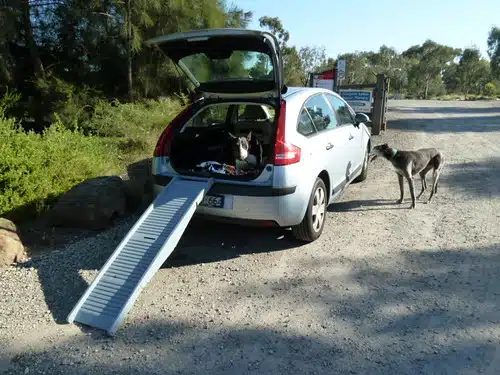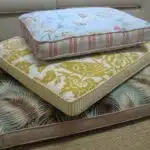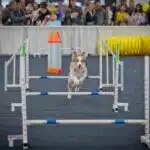Dog owners who share their homes with their furry friends often encounter challenges when it comes to accommodating their pets’ needs. One of the most common issues is providing easy access to elevated surfaces such as beds and couches. Dogs, especially those with mobility issues due to age or injury, can struggle to climb up and down from these heights, putting unnecessary stress on their joints and muscles. Fortunately, building a DIY dog ramp is a simple yet effective solution that can improve your pet’s quality of life while also allowing you to enjoy the comfort of snuggling up with them on the furniture.
As a DIY dog ramp building expert, I have seen firsthand how much of a difference this simple project can make for both dogs and their owners. Not only does it provide a safe way for your pet to access elevated surfaces without risking injury or discomfort, but it also promotes independence and reduces strain on your own body when lifting heavier dogs. In this article, I will guide you through the steps necessary to build your own dog ramp for the bed or couch using affordable materials and easy-to-follow instructions. By investing a little bit of time and effort into this project, you can enhance your bond with your furry friend while also fulfilling their innate desire for exploration and adventure.
The Benefits Of A Dog Ramp For Your Pet’s Health
Just like how pet friendly furniture has become increasingly popular, so too have dog ramps. These contraptions offer numerous benefits to your furry friend’s health and well-being. For starters, they prevent injuries that may occur when a dog jumps from high surfaces such as beds or couches. This is especially important for smaller or older dogs who are more prone to such injuries.
Aside from injury prevention, dog ramps can also help maintain your pet’s joint health. Jumping onto and off of high surfaces puts a lot of pressure on their joints and can lead to long-term damage. A ramp provides a gradual incline that allows your pet to climb up or down without putting unnecessary strain on their joints.
In addition, dog ramps are particularly beneficial for pets with existing conditions such as arthritis or hip dysplasia. These conditions make it difficult for dogs to jump or climb up stairs, making it even more important to provide them with an alternate method of reaching elevated surfaces. By investing in a dog ramp, you’re not only helping your pet avoid injury but also providing them with the opportunity to live their life comfortably and happily.
As we move forward in understanding the importance of our pets’ health, we must take into account their unique needs and abilities. This is where assessing your pet’s needs and abilities comes into play when considering building a DIY dog ramp for the bed or couch.
Assessing Your Pet’s Needs And Abilities
Before embarking on the construction of a dog ramp, it is important to assess your pet’s mobility needs. If your dog is aging or has a health condition that affects their ability to climb up and down the bed or couch, a ramp can be an invaluable tool in providing them with the independence they need to move around comfortably. To determine if your pet requires a ramp, consult with your veterinarian for a health assessment.
When assessing your pet’s mobility needs, consider their size and weight. Smaller dogs may not require as steep of a ramp as larger dogs due to their lighter weight. Additionally, take into account any existing joint pain or other health conditions that may affect their movement. It is important to note that ramps are not one-size-fits-all and should be tailored to accommodate individual pet needs.
Incorporating proper design elements into your dog ramp can significantly improve its effectiveness for pets with mobility issues. A gradual incline and non-slip surface will ensure safe access for pets while reducing the risk of falls or injuries. By taking the time to assess your pet’s needs and abilities, you can create a custom-designed dog ramp that will provide them with the support they need to navigate around your home comfortably.
Transition: Now that we have assessed our furry friends’ mobility needs adequately, let us focus on designing the perfect dog ramp for your home.
Designing The Perfect Dog Ramp For Your Home
When it comes to building a DIY dog ramp, there are several factors to consider before getting started. One of the most important aspects is customizing dimensions to meet your furry friend’s needs. The ramp should be long enough to provide a gentle slope, allowing for easy access onto furniture without causing any strain on your pet’s joints or muscles. Additionally, you will need to consider the height of the furniture and adjust the measurements accordingly.
Another factor to think about when designing your dog ramp is decorative options. While functionality is key, adding some personal touches can make the project more enjoyable and aesthetically pleasing. You can choose from a variety of materials such as carpeting, wood paneling, or even create a themed design that matches your home decor. Not only will this enhance the overall appearance of your dog ramp but it will also help to blend in with the surrounding area.
Finally, incorporating some emotional factors into this DIY project can make all the difference in creating a ramp that both you and your pet will love. Here are some bullet points:
- Think about how much easier life would be for your furry companion if they could comfortably climb onto furniture.
- Consider how happy it will make you to see them effortlessly climb up their new ramp.
- Imagine how grateful and loved your pet will feel knowing that you went out of your way to create something especially for them.
- Remember that building a DIY dog ramp is not just about function but also about showing love and care towards our furry companions.
As you move forward with this project, it’s important to keep these emotional factors in mind while still being practical and safe. In the next section, we’ll explore choosing the right materials for your DIY project so that you can build a sturdy and reliable dog ramp that meets all of your needs.
Choosing The Right Materials For Your Diy Project
Wood selection is an important factor in any DIY project, as the type of wood used affects strength, durability, and cost. Fasteners should be chosen based on the weight capacity of the project and the tools necessary to install them. Measurements should be precise and accurate to ensure safety and comfort. Finally, consideration should be given to finishes, supplies, design, size, strength, durability, comfort, maintenance, and cost when selecting the right materials for a DIY project.
Wood Selection
When it comes to building a DIY dog ramp for your furry friend, choosing the right wood is crucial. There are different types of wood available in the market, each with its unique properties that can impact the durability and longevity of your project.
One type of wood you might consider using for your dog ramp is hardwood. This type of wood is known for its strength and durability, making it an excellent choice for a ramp that will support the weight of your dog. Hardwoods like oak, maple, and cherry are popular choices because they are resistant to scratches and dents.
Another option to consider is pressure-treated lumber, which has been chemically treated to resist rot and insect damage. While this type of wood can be more expensive than other options, it can be a great investment if you want your dog ramp to last longer. Keep in mind that pressure-treated lumber may not be suitable for indoor use due to its chemical treatment.
In conclusion, choosing the right wood for your DIY dog ramp project requires careful consideration of the types available and their durability. Whether you choose hardwood or pressure-treated lumber, make sure to take into account your dog’s weight and how often they’ll be using the ramp. By selecting quality materials upfront, you’ll ensure that your furry friend has safe and easy access to their favorite spots on the bed or couch.
Fasteners
When it comes to building a DIY dog ramp, choosing the right materials is crucial for its safety and longevity. In addition to selecting the appropriate type of wood, using high-quality fasteners can also make a significant difference in the durability of your project. There are different types of fasteners available in the market that you can use for your dog ramp, such as screws, bolts, nails, and brackets.
When selecting fasteners for your dog ramp project, consider factors like weight capacity and material compatibility. For instance, screws are an excellent choice for securing wooden planks together since they provide a strong hold and are easy to install. Bolts, on the other hand, are more suitable for joining thicker pieces of wood or metal components since they offer greater stability and support.
To ensure that your fasteners are secured properly on the ramp surface, use appropriate tools like drills and wrenches. Avoid over-tightening or under-tightening your fasteners as this may compromise their strength and cause them to loosen over time. Additionally, avoid using fasteners made from low-quality materials as they may break or corrode easily.
In summary, choosing the right type of fasteners is vital when building a DIY dog ramp. Different types of fasteners have unique properties that can impact their strength and durability. By following tips like selecting appropriate materials and tightening them appropriately with proper tools, you can build a sturdy and safe dog ramp that will serve your furry friend for years to come.
Essential Tools And Equipment For Building A Dog Ramp
When building a dog ramp, it is essential to have the right tools to ensure that the process is as seamless as possible. Some of the must-have tools include a circular saw, jigsaw, drill, measuring tape, screwdriver set, and safety glasses. These tools are necessary for cutting and shaping the ramp components accurately.
In addition to the must-have tools, safety equipment is equally important when building dog ramps. Safety glasses will protect your eyes from flying debris during cutting and drilling. Also, gloves will provide a good grip on the tools while protecting your hands from cuts or injuries.
Overall, having the right tools and safety equipment is crucial when building a dog ramp. It not only ensures that you complete the job effortlessly but also guarantees your safety while doing so. In the next section, we will delve into how to measure and cut ramp components accurately using these essential tools and equipment.
Measuring And Cutting The Ramp Components
Accurately measuring the dimensions of the ramp components is critical for the successful construction of a DIY dog ramp. Appropriate tools should be selected for cutting the wood components to size, such as a table saw or jigsaw, depending on the size and shape of the desired cuts. Precise measurements and accurate cuts are essential for the construction of a safe and sturdy ramp. A cutting list should be prepared prior to commencing the cutting process, to ensure that all the necessary components are cut to the correct dimensions. A tape measure or ruler should be used to take the measurements, and the components should be marked out clearly on the wood before cutting. It is also important to check that the tools being used are set up correctly and the blades are sharp.
Measuring Dimensions
To build a successful DIY dog ramp, measuring accuracy is crucial. A ramp that is too steep or too long/short can cause injury to your furry friend. Start by measuring the height of your bed or couch and the distance from it to the floor. These measurements will determine the appropriate incline of your ramp. Be sure to measure accurately as even a small difference can affect the safety and effectiveness of the final product.
Adjusting incline is also important when measuring for a dog ramp. The ramp should not be too steep or your dog may have difficulty climbing up or down it, especially if they are older or have joint problems. It is recommended that a dog ramp has an incline of no more than 30 degrees for optimal safety and ease of use. Adjusting the incline may require some trial and error, but it is essential for ensuring that your furry friend can access their favorite spot without any risk of injury.
Once you have measured accurately and adjusted incline accordingly, you can move on to cutting your ramp components. Remember, safety always comes first! Use appropriate protective gear such as gloves and goggles when cutting materials such as wood or PVC pipes. Following these steps will help ensure that you build a safe and effective DIY dog ramp that will provide access to your furry friend in a comfortable way.
Cutting Wood
After measuring the height of your bed or couch and the distance from it to the floor, you can move on to cutting your ramp components. Cutting wood is a crucial step in building a DIY dog ramp, and it requires careful attention to detail and precise woodworking techniques. One of the most important things to keep in mind when cutting wood for your ramp is safety precautions. Always wear appropriate protective gear such as gloves and goggles to prevent injury.
Before you begin cutting wood, make sure that you have all the necessary tools and materials on hand. These may include a saw, drill, screws, sandpaper, and paint or stain if desired. It’s also important to choose the right type of wood for your project. You want something that is sturdy enough to support your dog’s weight but not too heavy or difficult to work with.
When cutting wood for your dog ramp, be sure to measure twice and cut once. This will help ensure that you get accurate cuts and minimize waste. It’s also a good idea to use clamps or other tools to hold the wood securely in place while cutting. With these tips in mind, you can build a safe and effective DIY dog ramp that will provide access to your furry friend in a comfortable way.
Selecting Tools
When building a DIY dog ramp, selecting the right tools is just as important as measuring and cutting the ramp components. The right tools will ensure that your project is successful and will make the process of building the ramp much smoother. When choosing tools for your dog ramp project, it’s important to consider factors such as the type of wood you are using, the size of your project, and your level of experience with woodworking.
To start with tool selection, you’ll need a saw for cutting wood to the desired length. A circular saw or jigsaw is ideal for this task. You’ll also need a drill for making holes in the wood and attaching screws. It’s best to use a cordless drill if you have one since it gives you more freedom of movement when working on your project. Additionally, sandpaper will be necessary to smooth out any rough edges on your cut pieces.
DIY tips can help you select additional useful tools for your project such as clamps or vice grips to hold wood securely in place while cutting. If you’re planning on staining or painting your dog ramp, then brushes and rollers will be needed too. It’s essential to remember that safety should always come first when selecting tools for your DIY dog ramp project, so always wear protective gear such as gloves and goggles while working on this task.
Assembling The Ramp Frame And Supports
Assembling the Ramp Frame and Supports:
Firstly, let’s focus on adjusting height. Prior to attaching the support beams, it is essential to determine the right height for your ramp. Measure from the bed or couch to the floor, ensuring that you factor in any type of cushioning or padding if present. Once you have determined the correct height, cut your support beams accordingly. Make sure to use a level tool to ensure that all sides are equal in length.
Next up is securing fasteners. After cutting your support beams, proceed with drilling holes where you will attach them onto the frame. It is recommended that screws be used rather than nails as they provide a stronger hold and prevent wobbling movements while in use. Be sure to secure each side firmly before moving on to attaching other components.
Lastly, position and attach your side rails for added stability and safety precautions. Ensure that they are secured tightly by using screws and bolts at both ends of each rail. Once completed, double-check all fastenings and connections before testing out your ramp with your furry friend!
With the frame and supports now securely assembled, it’s time to move on to installing the ramp surface and traction materials which will ensure safe access for your pet onto furniture without any accidents or injuries occurring!
Installing The Ramp Surface And Traction Materials
When building a diy dog ramp, the ramp surface is an important factor to consider. Adequate preparation of the ramp surface, such as sanding or priming, is necessary for optimal results. Installing traction materials, such as carpet or strips of rubber, will help ensure the safety of the dog. Securing the traction materials to the ramp surface is an essential step to prevent the materials from slipping or sliding.
Choosing The Ramp Surface
When it comes to building a DIY dog ramp for your bed or couch, selecting the right surface is crucial. Carpet and wood are two of the most common materials used for ramps, but determining which one is best for your furry friend depends on various factors. Carpet provides a soft surface that can help dogs with traction, making it an excellent option for dogs with mobility issues or those who are prone to slipping. On the other hand, wood is more durable and easier to clean, making it ideal for dogs that shed or drool.
Another factor to consider when choosing ramp material is whether to use foam or rubber as traction material. Foam offers a soft surface that can provide extra cushioning for dogs with arthritis or joint pain. It’s also lightweight and easy to cut, shape, and glue onto the ramp’s surface. In contrast, rubber provides superior grip and durability, making it an excellent choice for active dogs who love to run up and down the ramp.
Overall, there are several factors to consider when choosing the best ramp surface for your dog’s needs. These include considerations such as your dog’s size, weight, age, physical limitations, and activity level. By carefully evaluating these factors and selecting the right materials accordingly – such as carpet vs. wood or foam vs. rubber – you can create a DIY dog ramp that provides safe and comfortable access to your bed or couch in no time!
Preparing The Ramp Surface
Now that you have selected the appropriate material for your dog ramp, it is time to prepare the surface for installation. One important step is to sand down the surface of the ramp to ensure it is smooth and free of any rough edges or splinters that may harm your furry friend. Additionally, if you are using wood for your ramp, it is crucial to apply a waterproofing material to protect it from moisture damage.
Before installing the traction material onto your ramp’s surface, make sure it is clean and dry. This will ensure that the traction material adheres properly and lasts longer. You can use a damp cloth or mild detergent to clean any dirt or debris off the surface. Once dry, you can begin applying your chosen traction material, whether foam or rubber, in strips along the length of the ramp.
When installing traction material on your dog ramp’s surface, make sure there are no gaps between strips where your dog’s paw may get stuck. It is also essential to press down firmly while applying each strip to avoid air bubbles that may cause unevenness and reduce grip. By following these simple steps when preparing and installing traction materials on your DIY dog ramp, you can create a safe and comfortable access point for furry friends of all ages and abilities.
Adding Safety Features To Your Dog Ramp
With the ramp surface and traction materials in place, it’s time to focus on adding safety features to your DIY dog ramp. Safety is of utmost importance when it comes to building a ramp for your furry friend, as you don’t want them to slip or fall while climbing up or down. One way to ensure their safety is by adding grip to the ramp surface.
There are several ways you can add grip to your dog ramp. You can use a non-skid tape or paint that will provide traction for your dog’s paws. Another option is to use rubber mats or carpet tiles with a rough texture that will prevent slipping. No matter which option you choose, make sure that the material you use is durable and easy to clean.
In addition to adding grip, reinforcing joints is another crucial step in ensuring the safety of your DIY dog ramp. The joints are where most of the weight and pressure will be placed, so they need to be strong enough to support your pet’s weight without bending or breaking. Use sturdy screws and bolts when attaching the different parts of the ramp together and consider using extra reinforcement such as metal brackets if needed. With these safety features in place, your furry friend can safely climb up and down their new ramp with ease!
As important as safety is when building a dog ramp, we must not forget about aesthetics too! Finishing touches and decorative options can turn a simple DIY project into an eye-catching piece of furniture that complements any home decor style. In the next section, we’ll explore some ideas on how you can add some personality and style to your newly-built dog ramp without compromising its functionality.
Finishing Touches And Decorative Options
Staining is an effective way to customize the look of a DIY dog ramp. It is important to use a non-toxic, water-based wood stain for maximum safety and durability. Painting is an inexpensive and easy way to add personal touches to a DIY dog ramp. It is important to use a paint that is safe for pets and use multiple coats for a good finish. Decoupage is an effective way to add decorative elements to a DIY dog ramp. It is important to use acid-free glue and sealer to ensure the decoupage elements will last. Overall, these finishing touches and decorative options are great ways to customize the look of a DIY dog ramp.
Staining
A well-built dog ramp is not only functional but also a beautiful addition to any home. To achieve an aesthetically pleasing finish, one must carefully consider staining techniques and color options. Staining is the process of applying a color to the wood to enhance its natural beauty while providing protection against wear and tear.
When it comes to staining your DIY dog ramp, there are various techniques you can use to achieve different results. One popular technique is the wipe-on method, where you apply the stain with a cloth or rag in a circular motion. This technique creates an even finish and allows you to control the intensity of the color. Another option is brushing on the stain, which gives you more control over where the color goes and how much you apply.
In terms of color options, there are countless stains available on the market that can match any decor style. You can opt for classic wood colors like oak or mahogany or experiment with bolder hues like red or blue. It’s important to note that darker stains tend to show scratches less than lighter colors. Ultimately, choosing a stain that complements your existing furniture and fits your personal style will ensure your DIY dog ramp looks stunning as well as functional.
Painting
After carefully considering staining techniques and color options, another decorative option to enhance the appearance of your DIY dog ramp is painting. Painting allows for more versatility in color choices and can create a unique look that complements your home decor. Like staining, there are different painting techniques that can be used to achieve various finishes.
One popular painting technique is the use of spray paint. Spray paint provides an even and smooth finish that is easy to apply. It also dries quickly, so you don’t have to wait long before using your dog ramp. Another option is using a paintbrush or roller to apply the paint. This technique gives you more control over where the color goes and how much you apply, allowing for a more customized finish.
When choosing a color for your DIY dog ramp, consider the overall aesthetic of your home as well as any existing furniture or decor pieces. You can opt for classic colors like white or black, or experiment with bold hues like yellow or green. Additionally, you may choose to use multiple colors or create patterns on the ramp for added visual interest. Whatever color choice you make, ensure it’s durable and safe for pets.
In conclusion, while staining is a great option for finishing touches on your DIY dog ramp, painting offers more versatility in color choices and allows for unique customization options. Whether using spray paint or traditional brush techniques, choosing a durable and pet-safe paint will ensure your ramp looks beautiful while serving its functional purpose.
Decoupage
As a DIY dog ramp building expert, it’s important to not forget the importance of adding finishing touches and decorative options to your project. While staining and painting are popular choices, another option to consider is decoupage. This technique involves layering paper or fabric onto a surface using glue and sealant, creating a unique and creative design.
Decoupage techniques allow you to create intricate designs on your dog ramp that can add personality and charm to your home decor. You can use patterned paper or fabric that complements your existing furniture or choose a theme that reflects your pet’s personality. Additionally, decoupage provides an opportunity for customization as you can cut out specific shapes or words to incorporate into the design.
To ensure durability and safety for pets, it’s important to use a pet-safe sealant when decoupaging your dog ramp. This will protect the design from wear and tear caused by regular use. Overall, adding creative designs through decoupage techniques can elevate the look of your DIY dog ramp while also serving its functional purpose of aiding in your pet’s mobility.
Testing And Adjusting Your Dog Ramp For Optimal Performance
After successfully building your own dog ramp, it’s important to test and adjust it for optimal performance. This can help ensure your furry friend remains safe while using the ramp. To start, you’ll want to adjust the incline of the ramp. A steep incline may make it difficult for your dog to climb up or down, while a shallow incline may not provide enough traction.
Choosing the right traction materials is also crucial for optimal performance. The material should be slip-resistant and easy on your dog’s paws. One option is to use carpet or a rubber mat. Another option is to apply a non-slip tape or adhesive to the surface of the ramp. It’s important to regularly inspect and replace these materials as needed to maintain a safe and effective ramp.
By testing and adjusting your dog ramp, you can ensure that it meets your furry friend’s needs and preferences. Keep in mind that some dogs may require more time and patience when getting used to using the ramp. With a little practice, however, they will soon be able to safely and effectively navigate their way up and down from the bed or couch.
Training Your Dog To Use The Ramp Safely And Effectively
Now that your DIY dog ramp is complete and has been tested for optimal performance, it’s time to move onto the next step: training your furry friend. Training techniques will not only ensure your dog’s safety but also help them use the ramp effectively.
Start by introducing your dog to the ramp slowly. Place a treat at the bottom of the ramp and encourage your pup to walk towards it. This will help them get comfortable with the ramp’s surface and build confidence in using it. Gradually increase the incline and height of the ramp as your dog becomes more confident.
Safety precautions are also essential when training your dog to use the ramp. Ensure that both ends of the ramp are secure, either by attaching them to furniture or using anti-slip mats. Monitor your dog closely during training sessions to prevent any accidents or injuries. Remember, patience is key when teaching any new skill, so take things slow and give plenty of praise and rewards along the way.
Maintaining your dog ramp for longevity and durability is crucial for its continued use over time. Regularly check for wear and tear on the surface, ensuring that there are no splinters or loose screws that could injure your pet. If you notice any damage, make repairs immediately before allowing your pooch to use it again. Cleaning is also important; wipe down the surface regularly with a damp cloth to remove any dirt or debris that may have accumulated on it over time. With proper care, your DIY dog ramp can provide years of safe and effective use for you and your furry friend!
Maintaining Your Dog Ramp For Longevity And Durability
Keeping your DIY dog ramp in top condition is essential to ensure its longevity and durability. Regular cleaning is necessary to prevent the build-up of dirt, grime, and pet hair. Use a damp cloth or sponge with mild soap to wipe down the ramp’s surface thoroughly. Be sure to rinse it off with clean water and let it dry completely before use.
In addition to regular cleaning, weatherproofing your dog ramp can enhance its lifespan and durability. The most common method of weatherproofing involves applying a coat of polyurethane or similar sealant to the wood surface. This will help protect the wood from moisture damage and other outdoor elements that could cause it to deteriorate over time.
By following these simple cleaning instructions and weatherproofing techniques, you can keep your DIY dog ramp in excellent condition for years to come. With proper maintenance, your furry friend will be able to use their ramp safely and comfortably whenever they need it.
As much as we try our best to maintain our dog ramps, issues may still arise despite our efforts. In the next section, we will discuss some common problems that may occur with DIY dog ramps and how you can troubleshoot them effectively.
Troubleshooting Common Issues With Dog Ramps
As a DIY dog ramp building expert, I have seen many common mistakes made by pet owners when constructing their own ramps. One of the most frequent issues is not ensuring proper stability for the ramp, which can result in injuries to both pets and humans. To prevent this problem, it is important to use sturdy materials and secure the ramp firmly to the bed or couch.
Another issue that arises with DIY dog ramps is improper sizing. The ramp should be long enough to provide a gradual incline and easy access for your furry friend, but not so steep that they cannot safely climb up or down. Additionally, the width of the ramp should be sufficient for your pet’s size and weight, as well as any mobility aids they may require.
Preventing injuries is a top priority when building a dog ramp. It is essential to carefully follow instructions and take necessary safety precautions throughout the construction process. This includes wearing protective gear such as gloves and eye protection when handling tools or materials, as well as ensuring all screws, bolts, and other fasteners are securely tightened before use.
Moving onto frequently asked questions about DIY dog ramps…
Frequently Asked Questions About Diy Dog Ramps
If you’ve encountered some common issues with your DIY dog ramp, don’t worry! There are plenty of solutions to fix these problems. One common issue is the ramp being too steep for your furry friend. If this is the case, try decreasing the incline by making the ramp longer or adding more steps. Another issue could be that your dog isn’t using the ramp at all. In this case, it may be helpful to add some traction to the surface of the ramp or train your dog with treats and positive reinforcement.
Now that we’ve addressed some troubleshooting tips for your DIY dog ramp, let’s move on to some frequently asked questions about building one in the first place. One question that often comes up is how much a DIY dog ramp will cost. The answer to this depends on factors such as size, materials used, and any additional features such as rails or non-slip surfaces. However, generally speaking, a basic DIY dog ramp can cost anywhere from $30-$100.
Another question people ask is if there are any alternatives to building a traditional wooden or plastic dog ramp. Some alternative options include using an old set of stairs or repurposing furniture such as a bookshelf or end table into a makeshift ramp. Keep in mind that these alternatives may not be suitable for all dogs depending on their size and mobility needs.
- Did you know that ramps made from PVC pipes can be both lightweight and durable?
- A carpeted surface can provide added traction for dogs who struggle with slipping on smooth surfaces.
- Adding decorative touches such as paint or stickers can make your DIY dog ramp fit seamlessly into your home decor.
As a DIY dog ramp building expert, I highly recommend taking the time to troubleshoot any issues with your current ramp before giving up on it entirely. With some adjustments and patience, your furry friend can benefit greatly from having access to elevated surfaces without putting unnecessary strain on their joints. And if you’re considering building your own ramp, remember that there are cost-effective alternatives and creative options available to you. Happy building!
Conclusion
In conclusion, a DIY dog ramp is a practical and cost-effective solution for ensuring your furry friend’s safety and comfort. With proper planning, design, and construction, you can create a customized ramp that meets your pet’s specific needs and fits seamlessly into your home decor.
The dog ramp also serves as a symbol of our love and care for our pets. It represents our commitment to their well-being and our willingness to go the extra mile to make their lives easier. By building a dog ramp ourselves, we not only save money but also gain the satisfaction of creating something with our own hands that will benefit our loyal companions.
As an expert in DIY dog ramp building, I encourage all pet owners to consider this project as a way of enhancing their pet’s quality of life while strengthening the bond between owner and animal. Remember to follow safety guidelines, use high-quality materials, and train your pet properly to ensure a successful and long-lasting result. Happy building!
Image Credits
- “dogs and car and ramp” by annieb (featured)













![How To Repair Rotted Wood 14 Texture : Altario Buick Estate Wagon : Rotting Faux Wood Paneling [1 of 2]](https://green-life.blog/wp-content/uploads/2023/05/z1CersK-gCjq-150x150.jpg.webp)















